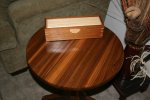- Messages
- 11,635
- Location
- Constantine, MI
On my mid century coffee table in cherry I had planned on using only Danish oil for finish on the sides, drawer fronts, and leg assembly. I was only going to varnish the top to offer some additional protection. I like the look and feel of the danish oil, five applications, but I am a little concerned about how well it will protect the wood. I know that Danish oil can be used as a finish coat and was wondering if anyone here had more experience with this than I.
What do you think? Five applications of danish oil? Sufficient?

What do you think? Five applications of danish oil? Sufficient?



